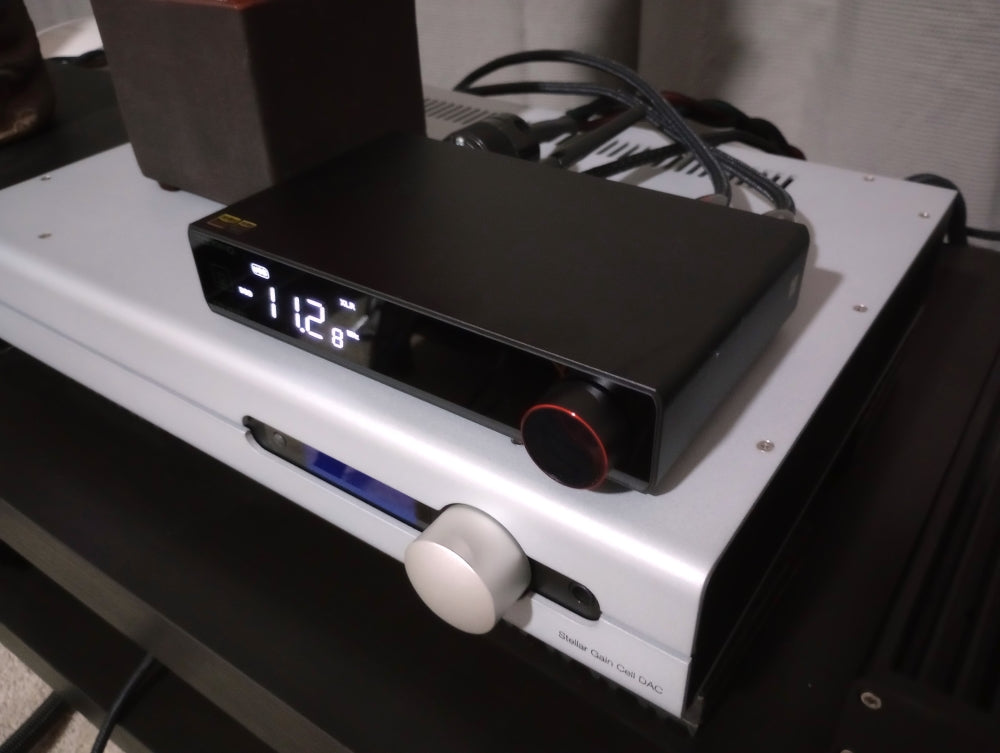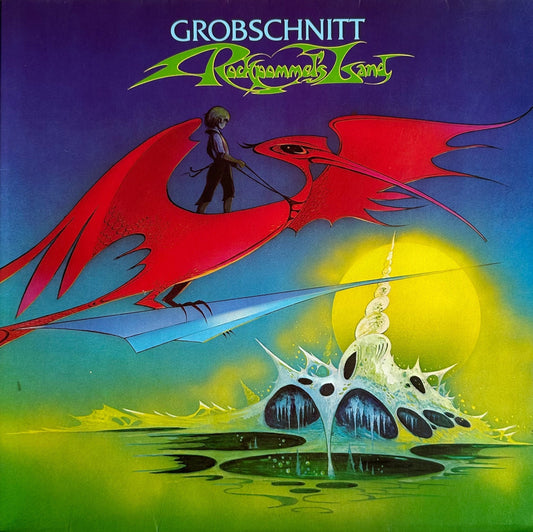Early February I was sitting around, surfing the net, and happened to come across a Facebook post from a group I belong to, SACD, DVD-A, & Blu-ray Audio Audiophiles. This particular post had several contributors debating the merits of SACD player internal DACs in terms of sound quality, a subject that I’m really quite interested in. I have a Yamaha BD-A1060 BD/SACD/DVD-A player that I currently have set up in my new analog room at the new house. I mostly use it to compare the sound of recent LP reissues with their SACD counterparts, if they exist. That said, I’ve generally been perfectly happy with the sound quality of the Yamaha player’s internal DAC, but since I started delving deeply into the ripping of SACDs a while back, I couldn’t help but wonder if there might be some room (within my limited budget) for improvement.
Anyway, back to the Facebook post; as I continued to read some of the responses, one of them included a link to a YouTube video, Play your SACDs through your outboard DAC! I expected that this video would present information about using an outboard device like a GeerFab Audio D.BOB (digital breakout box), or maybe just offer information on ripping SACDs to your music server. And while SACD ripping really works for both stereo and multichannel rips, it’s not exactly a walk in the park, and requires fairly massive storage capabilities for your music server. So imagine my surprise in finding that the video was actually about a Chinese-made HDMI-to-I2S converter device! This product apparently strips the converted signal of its copy protection, and presents native DSD to any DAC with an I2S input. It’s apparently also capable of sending both stereo and multichannel signals (for those with the capability).
Anyway, the video’s author talks about how well this box works, and that it only costs around $50 – 65 USD, depending on who you purchase it from (eBay is the most common provider). Reading the comments below the video, people rave about how this thing effortlessly supplies the DSD signal to any DAC – and how amazing the sound quality is compared to that from your disc player’s internal DAC. How I’ve never heard of this device before now, I have no idea!
The video’s author also includes a link to another YouTube video, How to send high-res audio from a Blu-ray/SACD/DVD player to a DAC via HDMI, which is the one in which he got the information about the HDMI-to-I2S converter in the first place. The video discusses three ways to stream native DSD to an outboard DAC. One is by using an OPPO-player specific mod, the second concerns a digital audio extractor, and the third is the HDMI-to-I2S converter we’re discussing here. Most of the comments following the video discuss the OPPO mod and the audio extractor.
As I noted above, my current system has the Yamaha universal player setup in my analog room, but I also still have the Gustard X16 DAC just sitting around, unused. It happens to be conveniently equipped with a more current DAC chipset than the Yamaha player, and it has an I2S output – making it a perfect candidate for a serious upgrade to my SACD playback. I also happen to have a couple of pretty decent AudioQuest HDMI cables lying about, so other than the converter, I was basically ready to go.

When you do a web search for “HDMI-to-I2S converter,” you generally get dozens of options for a nameless converter that usually retails for between $50 and $65. They all appear to be identical, with none listing a manufacturer or brand name – except one, which appears on Ali Express (that link has already expired; I’ll explain later), is labeled under the brand name TZT, and retails for $52.31. Never having ordered anything from Ali Express, I bookmarked that listing, then chose one from eBay ($52.99) and also bookmarked it.
The device’s appearance and specs on both listings were identical. Having had mostly positive results with eBay, I pulled the trigger, and after adding the device to my cart was immediately greeted by the information that I was only purchasing the board –getting a fully-assembled device was an additional $10. I backed out of the order, then clicked on the Ali Express link; I had to create an account, and the assembled device was the $52.31 price, delivered from China. I figured that they both shipped from China, and were absolutely identical, so why not go with the less-expensive one? I pulled the trigger and placed my order. However, at the time China was completely shut down for the Lunar New Year, so it took forever for the device to arrive. I can’t even begin to express my excitement to potentially be able to hear the output from my SACDs through a much better DAC in native DSD!

Setup and listening results with the TZT HDMI to i2S converter
I basically had everything ready to go for when the TZT converter arrived; I even had a linear power supply available to power it (the TZT came with no power source). After making the connections, I chose an SACD, placed it in the Yamaha’s tray, and pressed the play button. And was greeted by complete silence.
The player was playing the disc, but no sound was emerging from the system, so I confirmed that all the cable connections were intact – still nothing. At this point, I pulled up an online manual for the Yamaha player to confirm the output settings for DSD – which were cryptic, at best. The TZT converter has a pass-through HDMI connection, so I hooked up a monitor I keep in a closet (for exactly this kind of purpose) to the Yamaha player to look at the possible DSD output settings.
I started making what I thought were counterintuitive choices in the output settings to try and get the DSD signal to pass through to the TZT converter. After a couple of hours (!) of trying every conceivable combination of settings, I finally got sound – but it wasn’t the sound I was hoping for! I had almost perfect sound emerging from the right channel, but heard only static from the left channel. I spent about another two hours checking the cable connections and the Yamaha player’s output settings – everything I could possibly do to try and get sound out of the left channel – all to no avail. It appeared that I had gotten a bum unit from Ali Express.

The TZT converter may not be compatible with my particular system setup.
At this point, I reached out to them to try and get a replacement unit. Over the course of several days of increasingly ridiculous e-mail exchanges, I learned that Ali Express is mainly just a clearinghouse for resellers. You’re not really dealing with a company that fully supports everything they sell; they just act as an intermediary for the seller. After going through several rounds of “What seems to be the problem?” and “Send us photos of the defect,” and then dealing with a semi-functional website that wouldn't completely allow me to engage with the seller, I gave up and filed a complaint with my credit card company. I’m still waiting for a resolution, but I might be out the $50, and after this experience, I’ll never do this again — lesson learned.
New Information and a Disturbing E-mail from Dalibor Kasac at Euphony Audio
A day after filing the complaint, two things happened. First, I stumbled across a forum with entries regarding the implementation of the TZT converter, and apparently, it will only work perfectly with certain players. And less than perfectly with everything else –and the converter is likely using DoP (DSD over PCM) to make the conversion from HDMI to I2S. Bummer! The second thing was that I got an email from Dalibor Kasac of Euphony Audio (manufacturer of my streaming setup), telling me about a discovery that the guys at Euphony had just made. Apparently, if you’re using a delta/sigma DAC that employs ESS SABRE PRO chipsets, and are listening to anything in the DSD realm from DSD 64 through DSD 256, the output isn't actually native DSD.
In the aftermath of the 2020 Asahi Kasei Microdevices (AKM) fire that destroyed their Japanese factory, all delta/sigma DACs have been produced using ESS SABRE PRO chipsets instead of the AKM chips that were becoming all the rage with Asian manufacturers. It took three days to extinguish that fire, but AKM rebuilt, and just released their newest chips last fall, including the flagship AK4499EX DAC chips that will replay DSD natively at all rates! Dalibor was contacting me to tell me that Euphony had gotten a couple of the new Topping E70 Velvet DACs that incorporate the new chips, and the sound quality was beyond spectacular. If I could possibly get one, by all means, I should do so – he guaranteed I’d be just as astonished by the results as they have been.
I found Dalibor’s information about the ESS SABRE PRO chips’ DSD conversion to be incredulous, so I started looking at white papers on the ESS website for all their current top-line chips – and the information is clearly there. Their chipsets all convert DSD via DoP throughout the range from DSD 64 to DSD 256, and only the very highest DSD rate is replayed as native DSD with no conversion. That’s even true of their newest flagship chip, the ESS ES9039PRO, which allows for up to DSD 1024 natively – my current DAC, the Gustard X26Pro, has a pair of ESS ES9038PRO chips with the same limitations. As it turns out DoP isn't the problem – it's still technically native DSD – the problem has to do more with how ESS PRO chips process DSD files. And apparently, this is old news, and has been bounced around the audio internet for almost eight years! I can’t begin to tell you how that information shocked me – I think I had a more intense reaction to that revelation than some of the analog guys probably did during the big Mobile Fidelity controversy last year!
Of course, there are tons of audio professionals and audiophiles who will tell you that bits are bits, and digital is only 1s and 0s, and that none of this could possibly have any impact on sound quality, regardless of how native DSD is processed by a particular DAC's chips. Dalibor tells me they’ve been testing this premise for years now, and after listening to the latest AKM chips with the Topping E70 Velvet DAC, there's definitely a difference. Here’s the good news: after jumping through multiple hoops, I obtained a review sample of the Topping E70 Velvet DAC, which just showed up yesterday. Cold out of the box, the sound quality is superb, and I’ll share more about the experience next time.

The new Topping E70 Velvet DAC is in the house!
Until then, happy listening!
Please note: this article has been updated with a correction/deletion of a previously-included statement.
Header image courtesy of Tom Gibbs.



